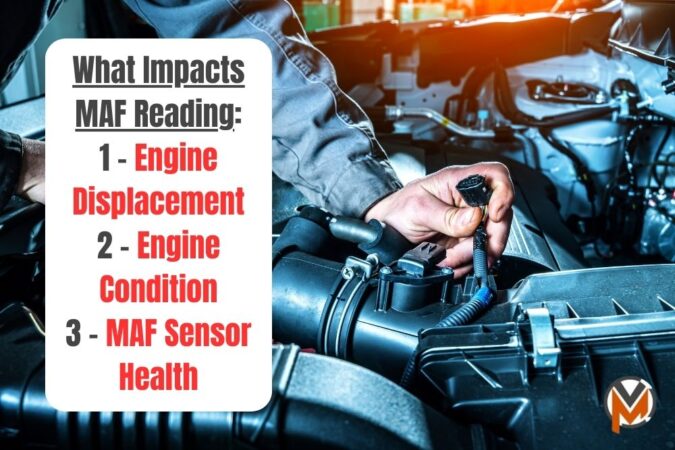Your car’s MAF (mass airflow) sensor is an important part of any vehicle, as it determines both the volume and the density of air entering the engine. However, what should the MAF sensor read when it’s idle?
In practice, there’s no one-size-fits-all reading, as your MAF sensor readings at idle can vary depending on the make and model of the car. Moreover, there are other factors to consider, like the size of your engine.
For example, a 3.0-liter engine might show an MAF sensor reading of around 3 grams per second (g/s) at idle. Meanwhile, a bigger 4.0-liter engine may show an idle MAF sensor reading of around 4 to 4.5 g/s.
Thankfully, there are simple ways to find the specific MAF sensor readings at idle for your specific car, like consulting your owner’s manual, a repair or service manual, referring to online databases, or calling a mechanic.
- What’s an MAF (mass airflow) sensor?
- What is the normal MAF reading at idle?
- Factors that impact your MAF readings
- Real-world examples of MAF readings at idle
- How to find the right MAF readings?
What Does A Mass Air Flow Sensor Do
When it comes to maintaining your car’s engine performance, understanding your MAF sensor (aka ‘mass air flow’ or ‘mass airflow’) reading is vital to determine the volume and density of air entering the engine.
All that airflow data is important for your Engine Control Unit (ECU) to balance and deliver the correct fuel amount to your engine for efficient combustion. The latter benefits both fuel efficiency and performance.
Your ECU (aka your car’s central computer brain) can use this airflow data to adjust and fine-tune the fuel injection rate accordingly to ensure optimal performance. Therefore, the MAF readings will fluctuate.
When your car and engine are idling, not much air is needed for it to continue running, which is where you would see lower MAF sensor readings. The readings will rise as soon as the engine needs to work harder.
Normal MAF Reading At Idle g/s
As noted earlier, the normal MAF readings at idle will vary based on the car’s make and model. However, a general rule of thumb is that the MAF readings should roughly correlate with the engine’s displacement.
For instance, a 3.0-liter engine might show an MAF reading of around 3 grams per second (g/s) at idle. It’s not a 100% fool-proof way of knowing what your car’s specific MAF readings are at idle, but it’s close enough.
Just to give you a rough example and some estimates, here’s what your MAF sensor should be reading at idle for a variety of engine sizes (and in scenarios besides idling, such as when you’re accelerating):
NOTE: Remember, these are just estimates, and the exact MAF sensor reading at idle for your specific car might vary slightly. We’ll include some tips later on for how you can find the right reading for your car.
1. MAF SENSOR READINGS AT IDLE:
- 1.6-liter Engine: Typically around 1.6 to 2.0 g/s.
- 2.0-liter Engine: Expect around 2.0 to 2.5 g/s.
- 2.5-liter Engine: Expect readings of 2.5 to 3.0 g/s.
- 3.0-liter Engine: Typically, a MAF reading around 3.0 g/s.
- 3.5-liter Engine: Readings might be around 3.5 to 4.0 g/s.
- 4.0-liter Engine: Readings might be approximately 4.0 to 4.5 g/s.
2. MAF SENSOR READINGS UNDER LOAD & ACCELERATION:
- 1.6-liter Engine: Readings can increase to around 8.0 to 12 g/s.
- 2.0-liter Engine: Expect readings of around 10.00 to 14.00 g/s.
- 2.5-liter Engine: Expect a surge to 18.00 to 22.00 g/s.
- 3.0-liter Engine: MAF readings can jump from 15.00 to 20.00 g/s.
- 3.5-liter Engine: Readings might jump from 26.00 to 32.00 g/s.
- 4.0-liter Engine: Readings might increase from 25.00 to 30.00 g/s.
3. MAF SENSOR READINGS CRUISING AT HIGHWAY SPEEDS:
- 1.6-liter Engine: Readings around 5.00 to 7.00 g/s.
- 2.5-liter Engine: Typically 12.00 to 16.00 g/s.
- 3.5-liter Engine: Expect about 20.00 to 24.00 g/s.
As we can see with the aforementioned MAF sensor readings, when your car’s engine is under heavy load, such as when you’re accelerating hard, the engine requires more air, which leads to higher MAF figures.
Meanwhile, when you’re applying a constant load, such as cruising at a gentle speed on the highway, the MAF readings lower massively, as the engine doesn’t need that much air to maintain a constant speed.
On the other hand, when you’re going even slower, like when you’re decelerating, the MAF readings often continue to drop even more significantly, usually close to idle readings, due to reduced air demand.
What Factors Impact Your Car’s MAF Readings
Speaking of, there are a myriad of other factors and variables that explain why the MAF readings at idle is varied from one vehicle to the next. Here are some of the noteworthy ones to take into account:
- Engine Size & Displacement:
- Larger engines have greater air intake needs, resulting in higher MAF readings.
- The correlation between engine displacement and airflow is not linear but proportional.
- Engine Condition & Health:
- A well-maintained engine ensures optimal and efficient airflow, reflected in accurate MAF readings.
- Issues, like clogged air filters or vacuum leaks, can cause lower-than-normal readings due to restricted airflow.
- MAF (Mass Airflow) Sensor Condition:
- Dirt or oil on the MAF sensor can impede its ability to measure airflow accurately.
- A faulty sensor might send incorrect signals to the ECU, leading to improper air-fuel mixtures.
Real-World Examples & Case Studies On Idle MAF Readings
To provide additional context and examples of how those aforementioned factors impact your car’s MAF sensor readings at idle, here are some examples and case studies based on real vehicles:
- 2002 BMW 330i (3.0L Engine): MAF readings around 3.6 to 4.2 g/s at idle.
- Toyota Tacoma 3.4L (5VZ-FE Engine): Idling range of 3.3 – 4.7 gm/s.
- Ford F-150 5.0L V8: At idle, expect MAF readings around 5 to 5.5 g/s. Under heavy load, this can surge to 30-35 g/s.
- Honda Civic 1.8L I4: A smaller engine like this typically shows 1.8 – 2.2 g/s at idle.
- Chevrolet Silverado 6.2L V8: Idle readings can be around 6.2 to 6.7 g/s, reflecting its larger engine displacement.
- Volkswagen Golf 1.4L TSI: For this compact car, expect idle readings of approximately 1.4 – 1.8 g/s.
- Mercedes-Benz Sprinter Van 3.0L Diesel: A diesel engine like this might show 3.0 – 3.5 g/s at idle.
How To Find & Know What Your MAF Readings Are
If you’re unsure about what your specific car’s MAF sensors should be reading – at idle or otherwise – here are some things that you can do to make that determination, and find the ideal MAF sensor readings:
- Consult the Owner’s Manual:
- Most automotive owner’s manuals provide specific MAF reading ranges for different operating conditions. Otherwise, you could also turn to service and repair manuals for more specific MAF sensor readings.
- Use an OBD-II Scanner:
- Connect an OBD-II diagnostics scanner tool to your vehicle to get the real-time MAF readings (i.e. when it’s idle). Most OBD-II should have some sort of live data capture functionality.
- Compare these readings with the standard values for your car’s make and model. To do this, reference the live data and output from the OBD-II scanner, and refer to your owner’s manual or a database.
- Check Online Forums and Databases:
- Automotive forums often have threads discussing MAF readings for specific models. For optimal results, I’d recommend visiting forums that discuss or are focused on the same makes and models as your car.
- Manufacturer-specific databases may provide detailed MAF reading charts. A lot of car manufacturers will sometimes include these PDFs online for mechanics and diagnosis, but you might be able to access them, too.
- Consult a Professional:
- If you’re still unsure, I’d always recommend calling up a trusted mechanic or automotive technician. In this case, a professional mechanic can provide accurate MAF readings and interpret them for you.



